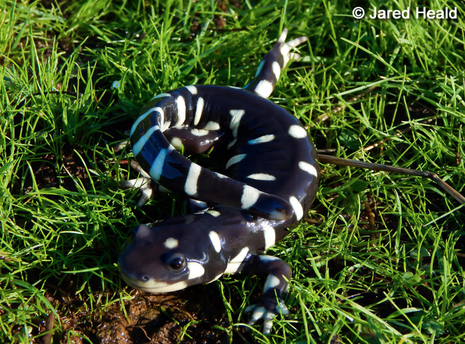 Californian Tiger Salamander (Picture via: CaliforniaHerps.com) Californian Tiger Salamander (Picture via: CaliforniaHerps.com) California is home to the Californian tiger salamander, which has a scientific name Ambystoma californiense. It is an amphibian that has large round snouts and has small eyes with black iris. They are called tigers because of the yellow bars on their skin. The males of species can be distinguished from the females by the presence of swollen cloacae during the mating season. An adult male of the species can be up to 8 inches, and females are smaller in size, and can be about 7 inches. They eat insects and larvae of other species. They are restricted to grasslands, and their natural breeding spots are small water bodies and ponds. The Tiger salamander mostly lives under the soil in the burrows made by squirrels because it is not particularly good at burrowing. They also use these burrows made by other animals for hibernation, and they stay there for the dry months. They then come out in November. They are preyed upon by birds and fishes. They are now a species under threat because of the destruction of their habitat and also the reduction of the squirrel population, which makes the burrows less available to them. They are also killed in heavy numbers while crossing busy roads. On the other hand, the barred tiger salamander, Ambystoma tigrinum mavortium, is the largest terrestrial salamander in the world, with a length of up to 14 inches. They have a small round head on thick bodies and vary in color from subspecies to subspecies, ranging from black, brown, grey and yellow with greyish-yellow stripes. They are nocturnal and eat small invertebrates. Their breeding season goes on all year. They gather around water bodies in clusters, and they also exhibit two stages of development. The first one is the aquatic stage, in which they have external gills. For this period, they’re known as “water dogs” and are often sold as fish baits. They are also called mudpuppies, which is actually wrong; that is a whole different species entirely. As adults, they retain their gills (neotenic). Habitat & Distribution It is very important to know what habitat each of these species has and how crucial it is for them. In the US, the Californian tiger salamander is restricted in the Central valley of California with small population around Santa Barbara, Sonoma, Yolo, and Kern Counties. They are mostly found at the grasslands or low foothills where they use the vernal water bodies and ponds for reproduction. As for the barred tiger salamander, it is found in western Canada and the western half of the United States of America. In Canada, it is known from British Columbia and Alberta. In the United States, its range is from the southernmost tip of Texas but no further east than Dakotas and Oklahoma. It has been introduced to Arizona. It is a terrestrial species and primarily found in deciduous forests, coniferous forests, and open fields, grasslands, and semi-desert areas. How and Why did they Invade? The cause of the invasion is due to the import of the eggs of the tiger/barred salamander. They were extensively used as fish baits. Barred tiger salamanders are preferred over the local variety due to their large size in the larval form and also because they had a longer larval stage. They were extensively released in the ponds back in the 1950s and 1960s. These released larvae were supported by natural selection, and they were already adapted to the environment, which resulted in rapid growth and hybridization. The hybrid is bigger and better than the parents due to their aggressive nature and voracious appetite. Genome analysis helps us in many ways to determine the size of the population, which helps us analyze the chances of survival of a species. Research made by Benjamin M. Fitzpatrick, Jarrett R. Johnson, and H. Bradley Shaffer showed that biomarkers were introduced for certain genes to document hybridization. It was seen that the invasive gene had a high success rate in the given environment and also that the hybrid species had higher fitness than both the other species, i.e., tiger and barred salamander. Another research conducted by Maureen E Ryan of the University of Washington also showed that the presence of invasive species has negatively impacted the local species. The native species are smaller in size and have a longer period of metamorphosis. In comparison, the invasive barred tiger was larger and had a smaller duration of metamorphosis. And this hybridization influenced by the genetic and ecological factors presents a threat to the tiger salamander population. Hybrid Super-salamander: A dilemma for both speciesBut why are we stressing over the change in the population of salamanders? What will happen if this hybridization is unchecked? The tiger salamander was doing just fine for thousands of years; they have been evolving and getting cozy in their habitat in California, but this unnecessary hybridization is uncalled for and is due to human involvement. There was absolutely no indication of a need for hybridization. The hybrid that appears as a result of the combination of the genes of the two salamanders might seem fitter than their ancestors. Still, the combination of alleles is not always “healthy”; most of the hybrid ones are infertile. This hybrid species, no matter how fit, will cause a decline in the number of the parent species because they fail to reproduce. Should these hybrid salamander populations, who fared to survive better than the parental species, be eradicated only to preservethe native tiger salamanders that have been losing their habitat for decades? If so, one of the first things that can be done for the growth of native tiger salamanders is the protection and propagation of habitat. Their habitat must be protected to ensure the feeding and breeding grounds for them. They also require to travel barrier-free for the purpose of reproduction. They are mostly killed by cars while crossing the road, so a strategy to lessen road kills must be devised. Protection of the ground squirrel species is very important. These salamanders use the burrows made by the rodents for locomotion and hibernation. Burrows are critical for their survival. Another thing that can be done has been inferred by the close study of their habitat. It has been seen that vernal pools, which are crucial for the reproduction of the tiger salamander, dry up in April; if the pool is maintained for long enough, they can help the metamorphosis and subsequent descent of the salamander in the soil. But most hybrids follow a different strategy; they stay in their larval form all year. So the emptying and filling of the water pools at a specific time of the year can help boost the tiger salamander’s growth and decrease the growth of the hybrid. References "Rapid spread of invasive genes into a threatened native species". Benjamin M. Fitzpatrick, Jarrett R. Johnson, [...], and H. Bradley Shaffer "Invasive hybrid tiger salamander genotypes impact native amphibians". Maureen E Ryan et al. Proc Natl Acad Sci U S A. 2009. AuthorNida Riaz is a freelance blogger based in Pakistan. She started writing about her passion for the environment when the world came to a stop in early 2020.
1 Comment
|
|
|
(833) CMS-LINE
(833) 267-5463 PO Box 13477 Mill Creek, Wa, 98082 © Conservation Made Simple. All rights reserved.
501(c)(3) Non-Profit, Tax ID#: 82-1646340 Copyright © 2021 Conservation Made Simple |


